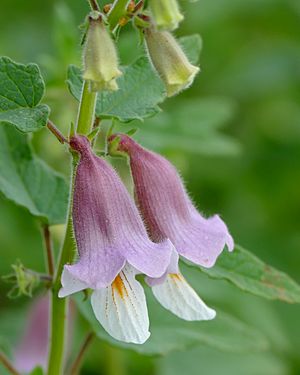Ceratotheca sesamoides facts for kids
Quick facts for kids Ceratotheca sesamoides |
|
|---|---|
 |
|
| Scientific classification | |
| Genus: |
Ceratotheca
|
| Species: |
sesamoides
|
Ceratotheca sesamoides is a flowering plant often called false sesame. It looks a lot like the common sesame plant. This plant grows naturally in Africa and is also farmed by local people. You can find it in the African Savannah and other dry areas, especially south of the Sahara desert. It likes sandy soils.
You can spot false sesame by its hairy stem and pink flowers, which often have brown and purple dots. It usually grows upright. This plant is very useful! Its leaves and flowers can be eaten as vegetables or used in sauces. The leaves also have some traditional medicine uses, and its seeds can be pressed to make cooking oil. Even though it's so useful, many people don't fully use or appreciate it.
Contents
What Does False Sesame Look Like?
False sesame is part of the Pedaliaceae plant family. It's an annual plant, meaning it grows and flowers within one year. It usually reaches about 60 cm tall, but can sometimes grow over 100 cm. It's a thin, upright plant with green leaves and flowers that can be pink, mauve, or lilac.
The fruit of false sesame looks like the fruit of regular sesame plants. It's a flat pod with thin "horns." These horns are a good way to tell it apart from regular sesame, which doesn't have them. False sesame is a dicot, a type of plant with two seed leaves. It first grew in West Africa but has now spread across the continent. You can find it from Senegal all the way to Tanzania, the Democratic Republic of the Congo, and even south to Botswana and Mozambique.
How False Sesame Grows
False sesame often has stems that spread out, with ten or more creeping branches. If you trim the younger shoots often, the plant will keep growing leaves and flowers for a longer time. This means you can harvest from it for longer!
C. sesamoides mostly pollinates itself. Its flowers open in the morning. After pollination, it takes about six weeks for the fruit to fully ripen. The seeds start to grow when the rains begin. Like other plants in its family, false sesame has special glands that produce a sticky substance called mucilage. This helps the plant survive dry periods without dying, making it very drought resistant. False sesame can grow in many different places. It grows as a weed and in farms. It does best in sandy soils that drain well and get lots of sun. It doesn't grow as well in rocky areas.
Farming False Sesame
Even though false sesame grows wild, it's quite easy to farm. It's a tough plant that doesn't need much care, just a little weeding. Because it can grow in different environments, farmers can plant it alongside other crops. These include eggplant, cowpea, amaranth, sorghum, sweet potato, and even regular sesame.
False sesame seeds don't need a resting period before growing, and the plant is usually resistant to pests. It often only deals with small pests. In Burkina Faso, it's known as one of the most disease- and pest-tolerant vegetables. If you want to learn more about it, there's a collection of Ceratotheca sesamoides plants from western Sudan at the Agricultural Research Corporation in Wad Medani, Sudan.
Many Uses of False Sesame
Ceratotheca sesamoides is a plant with many practical uses. When its leaves are cooked directly in soups, the sticky mucilage helps keep nutrients from being lost. The leaves can be chopped finely and used in different sauces. A common sauce is made with chopped leaves, groundnut flour, salt, onions, tomatoes, and a little hot water. This is often eaten with porridge. Sometimes, ash is added to the leaves to make them less bitter.
The seeds can be ground into a fine paste and mixed with common foods like beans and cassava. You can also crush the seeds to get oil. This oil is almost exactly like sesame oil and can be used in salads or for cooking. When making shea butter, adding the sap from false sesame leaves to the boiling pulp of Vitellaria paradoxa helps separate the fat. The leaves can also be used to feed livestock.
People also believe false sesame has health benefits. Local communities in Africa use it to help with various health issues. For example, extracts from the leaves are used to help with stomach problems like diarrhea. Some traditional practices involve grinding warm leaves with ash and applying them to swollen glands to help with childbirth. A mixture of ground leaves and the root of Anchomanes difformis has been used in traditional medicine to treat skin conditions.

